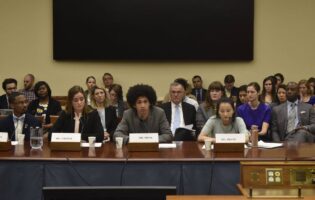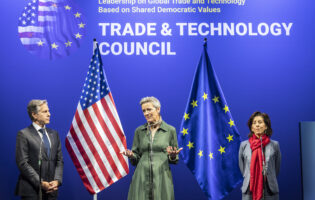Domestic Structures in Germany and Japan and Their Influence on Reconciliation Policy

Alexander Wochnik
Alexander Wochnik holds a PhD in Politics and International Relations from Aston University, UK. His research focuses on German foreign policy, Polish foreign policy, and Polish-German relations. He was a Harry & Helen Gray/AICGS Reconciliation Fellow in the summer of 2012; a Japanese Society for the Promotion of Sciences (JSPS) Postdoctoral Researcher at Hitotsubashi University in Tokyo in 2014; a Research Fellow at Manchester University, UK (2013-14); and in 2016 a DAAD/AICGS research fellow assessing German multilateralism through security relationships: German-U.S. Cooperation in Afghanistan. Alexander has published in the international peer-reviewed journals Geoforum, German Politics, West European Politics, and East European Politics and Societies.
He is a 2016-2017 participant in AICGS’ project “A German-American Dialogue of the Next Generation: Global Responsibility, Joint Engagement,” sponsored by the Transatlantik-Programm der Bundesrepublik Deutschland aus Mitteln des European Recovery Program (ERP) des Bundesministeriums für Wirtschaft und Energie (BMWi).
Comparing reconciliation politics of different states helps us to understand better the reasons why reconciliation, i.e., the process of normalization of bilateral relations after conflict between former perpetrator and victim states, is or is not taking place. In order to gain valid insights, a rigorous analytical framework is needed which can be applied to all countries and regions. Dr. Lily Gardner Feldman’s work compares Germany’s reconciliation policy vis-à-vis France, Poland, the Czech Republic, and Israel, and convincingly introduces this framework through a cross-examination of history, leadership, institutions, and the international context.[1] A comparison of policies emanating from two different perpetrator countries could shed new light on issues that one would, when focusing on only one perpetrator state, otherwise not consider.
Comparing Germany and Japan reveals such new insights. Based on a brief comparison of the two states, I argue in the following that the domestic structure, i.e., how the polity and politics of states are organized, is also an important factor that has an impact on the possibility and process of reconciliation. This factor should be included in future reconciliation research and could render valuable information to practitioners who need to make decisions how to structure the polities of states after conflict.
By comparing cases, it is helpful to categorize different variables that might influence reconciliation. This does not only aid the work of academics, but also helps practitioners to address issues that require alteration if reconciliation is meant to succeed. In Gardner Feldman’s framework, four factors contributing to reconciliation are identified: history, leadership, institutions, and the international context. It is important to note two things: first, these factors all influence each other. The international context can exercise pressure on leaders to launch reconciliation. Visionary leaders create joint institutions which in turn interlock leaders and commit them to action. History is the constant source for inspiration, the feelings of shame, guilt, revenge, and forgiveness for leaders and society alike. Second, it is difficult to determine with certainty which of the above-mentioned factors contributes the most to reconciliation.[2]
I would like to turn the attention to an understudied factor in reconciliation literature: domestic structures. Gardner Feldman indirectly notes the impact domestic structures (the role of the chancellor) can have on reconciliation without making it a separate variable. Here, the variable institutions entail not only joint institutions that states share such as the EU, but also the interaction between governments and societies. She categorizes societal actors according to their activities in relation to their home government as catalysts, complements, conduits, or competitors.[3] However, whether and how societal actors influence concrete government policy depends to a large degree on the domestic structures since they pre-determine the relationship of the government to its society. For example, well-defined lobbying legislation not only legitimizes societal actors’ influence seeking, but also makes the process more transparent and makes it easier for those actors which do not have a lot of resources available to access policymakers. Other authors frequently refer to domestic constraints to reconciliation without going into detail, thereby ignoring domestic structures as a variable. This has been frequently done to explain the Japanese prime ministers’ visits to the controversial Yasukuni shrine.
It becomes more apparent why domestic structures matter when comparing the German with the Japanese case. Then German Chancellor Willy Brandt’s famous Kniefall in Warsaw in December 1970 is widely acknowledged as an important symbol of reconciliation and hailed as visionary, future-oriented leadership. The spontaneous gesture was followed by the practical aspect of Ostpolitik, which included the West German de facto acknowledgment of the Oder-Neisse line as the definitive border between Germany and Poland. Despite vociferous opposition to the 1970 “normalization” treaty from the Federation of Expellees, despite the abstention of the CDU/CSU faction in the Bundestag during the ratification of the treaty, and despite the Constitutional Court’s 1973 ruling that the border would only be finite if recognized by a reunified Germany, the SPD-FDP coalition’s acknowledgment of the border launched the irreversible (but not without backlash) process of reconciliation with Poland. One is inclined to rightly credit the visionary leadership of Willy Brandt and Secretary of the Chancellor’s Office, Egon Bahr,[4] the mastermind behind Ostpolitik, for their role in the process of reconciliation with Poland. However, it should not be forgotten that the Kennedy and de Gaulle administrations exercised a lot of pressure on the preceding Adenauer government to engage more in détente (international context). Likewise, Germany’s society, especially the role of the churches and the Protestant and Catholic lay movements, prepared reconciliation in spirit[5] so that a sole focus on leadership does not do justice to the whole equation that made reconciliation possible. Furthermore, by comparing Germany to Japan I argue that it becomes possible to identify the features of the German polity that have been the precondition to the German leadership’s action, the a priori factor that determines the likelihood for reconciliation. To illustrate this point, let us ask: where is Japan’s Willy Brandt?[6]
One could blame the lack of international pressure during the Cold War for the absence of a substantial Japanese reconciliation policy. The U.S. was simply content to maintain a bulwark against Communism in East Asia and paid the lack of Japanese non-engagement with its past no attention, thereby sanctioning this policy.[7] Furthermore, Japan was not embedded in a regional framework, as Germany was in the European integration project where the EU “monitors” Germany’s behavior. Also, Japan was not divided as Germany was. This meant that Japan did not need to tread carefully on the international stage like Germany in order to achieve reunification as a long-term goal. In addition, well until the 1980s neither the South Korean nor the Chinese governments were much interested in Japan’s atrocities or apologies so that an important incentive for reconciliation was lacking. At the same time, there were also societal pressure groups that advocated a more reconciliatory stance by the government (especially toward China) during the Cold War. For obvious reasons Japanese businesses were much in favor of reconciliation along with the Japan-China Friendship Association. So why did those societal groups not prevail in their preferences? Why could they not prepare the ground for a brave step of a Japanese Willy Brandt?
One could attribute the lack of a Japanese Willy Brandt to Japan’s domestic structures. In Germany, Ostpolitik was only made possible when the Social Democrats (SPD) formed a government with the Liberal Party (FDP) and the vested interests that lay (and to a certain extent still lie) with the Christian Democrats (CDU/CSU) in form of the Federation of Expellees went into opposition. Furthermore, the German chancellor assumes a strong position in German politics. She or he is usually not only the chairperson of his/her own party, but can also shape domestic policies by setting the general guidelines (Richtlinienkompetenz). The chancellor is also a powerful figure in foreign policy. This is partially a result of path dependency and the fact that Konrad Adenauer was not only the Federal Republic’s first chancellor but also its first foreign minister.[8]
In Japan the prime minister is not as powerful as the title would entail in other democracies. The sheer number of incumbents, thirty-three since 1945, already hints to important structural differences that might limit the possibility for the launch of reconciliation policies. Although the conservative Liberal Democratic Party of Japan (LDP) was in power from 1955 until 2009,[9] the political system has produced four times as many heads of government than Germany (8). The main reason can be found in the fact that the LDP has long consisted of competing factions (habatsu) that tried to balance their influence, resulting in the consensus-based nomination of weak prime ministers. In addition, until 2002 the rotation of the party presidency every two years[10] resulted in further “hollowing out from within” of the prime minister’s quite extensive powers granted in the 1946 Constitution. In such a political environment it is very difficult to imagine a charismatic leader on top of government, someone who would pursue a policy against the majority position of his own party and the entrenched interests. The German chancellor, in contrast, has significantly more room to maneuver. For example, Chancellor Gerhard Schröder openly threatened the SPD with early elections in case his members of the Bundestag and party would not back him on controversial social reforms (Agenda 2010). In Japan the LDP would simply replace the prime minister.
The conservative LDP’s electoral base lives in rural areas and the electoral districts have been drawn in such a way that the rural areas have been overrepresented favoring the LDP. Furthermore, a first-past-the-post electoral system in the House of Representatives existed until 1996, favoring the LDP in rural areas and preventing the opposition Social Democratic Party of Japan (JSP) from ever coming to power. This means that conservative interest groups such as the Japanese Association of War Bereaved Families (Nihon Izokukai) would always, through the LDP, be present in parliament and government. The Izokukai could hence capture the Ministry for Health and Welfare and lobby for extensive welfare provisions for its members, lobby various government officials to visit the controversial Yaskuni shrine, and even initiate plans to build a war museum that would interpret Japan’s involvement in Asia during World War II as an act of liberation. This was planned with the so-called Showa Hall, the idea for which originated in 1979 although the public was not aware of it well into the 1990s. In the end, under massive societal protests, the museum’s content was defused so that the museum only displays the hardships of life in Japan during the war.[11]
As was noted above, the SPD’s Ostpolitik and the recognition of the border was only made possible when the party together with the FDP replaced the CDU/CSU-led government in 1966. In Japan, only when the LDP displayed weakness in 1993 through open quarrel and disintegration, could the opposition enter government. Once the high structural hurdle was overcome and Tomiichi Murayama, the first socialist prime minister in almost fifty years, was in office did reconciliation gestures enter the picture. For example, on the occasion of the fiftieth anniversary of the war’s end, Murayama apologized for Japan’s history[12] and this speech continues to be quoted as Japan’s official position on the subject. The weakness of the LDP in the early 1990s finally allowed for electoral reform. In 1996, the plurality voting system was replaced by a mixed-member parallel system and now 300 representatives are elected by first-past-the-post in the constituencies and 180 representatives are elected according to proportional representation.[13] This allowed other parties to share power. In 2009, the Democratic Party of Japan (DPJ) formed the government under which some progress on the reconciliation agenda was made, such as the refusal of the prime minister to visit the controversial Yasukuni shrine.
The head of state institution has also played in reconciliation policies. In Germany the Federal President (Bundespräsident) is elected for maximum two terms of five years. He/she is elected by the Federal Convention (Bundesversammlung), which consists of the two legislative branches and a few representatives from society. His duties are mostly ceremonial. This was designed following the lessons learned after the collapse of the Weimar Republic. It also grants the president autonomy from the daily political practice giving enough leeway to do something “out of the box.” Richard von Weizsäcker’s 1985 speech in parliament was such an act that also contributed to reconciliation. All subsequent presidents contributed actively to reconciliation with Germany’s eastern neighbors. In Japan, the head of state is the emperor (tenno), making Japan a constitutional monarchy. This means that an incumbent always represents the Japanese historical legacy, which is attached to the throne. This may obstruct reconciliation with other nations considerably. Emperor Hirohito, who reigned from 1926 until 1989, represented to the victims Japan’s militarism that caused the tragedy in Asia. Although Hirohito refused to visit the Yasukuni shrine after the enshrinement of fourteen class-A war criminals in the 1970s, it is doubtful that the emperor could have initiated little else to foment a process of reconciliation that would have been perceived by Japan’s neighbors as honest. Nevertheless, the over two millennia old institution bears the potential for a far-reaching gesture that could untangle the gridlock that seems to prevail in Japanese reconciliation efforts. However, perceptions matter in reconciliation and an elected head of state would most likely experience fewer reservations. The visit of British Queen Elizabeth II to Ireland has also caused controversy there for much similar reasons, underlining this point.
This short essay has argued that domestic structures play a vital role in reconciliation between former victims and perpetrators. By comparing Germany and Japan the essay shows that institutions such as the head of state, the actual powers the governmental leaders enjoy, and the electoral system seem to matter. Moreover, an opposition that is able to change government seems not only to benefit democracy, as Winston Churchill would concede, but also reconciliation. The relationship between society and policymakers does also play a role, but could not be elaborated here in detail. It must be noted that domestic structures are only one variable that influences reconciliation. The courage of leaders, the international context, joint institutions, and history all contribute to this process. I therefore advocate a more systematic comparison of the domestic structures of former perpetrator states (and perhaps between states that experienced internal conflict) to detect common patterns.
Mr. Alexander Wochnik was a Harry & Helen Gray Reconciliation Fellow at AGI in August and September 2012.
[1] See Lily Gardner Feldman, “The Principle and Practice of ‘Reconciliation’ in German Foreign Policy: Relations with France, Israel, Poland and the Czech Republic,” International Affairs 75:2 (April 1999), 333-356, “Non-State Actors in International Relations: The Case of Germany,” in Europe in Change, ed. Anne-Marie Le Gloannec (Manchester: Manchester University Press, 2007), and Germany’s Foreign Policy of Reconciliation: From Enmity to Amity (Lanham, MD: Rowman & Littlefield , 2012).
[2] Lily Gardner Feldman, Germany’s Foreign Policy of Reconciliation: From Enmity to Amity (Lanham, MD: Rowman & Littlefield , 2012).
[3] See Lily Gardner Feldman, “The Principle and Practice of ‘Reconciliation’ in German Foreign Policy: Relations with France, Israel, Poland and the Czech Republic,” International Affairs 75:2 (April 1999), 333-356, “Non-State Actors in International Relations: The Case of Germany,” in Europe in Change, ed. Anne-Marie Le Gloannec (Manchester: Manchester University Press, 2007), and Germany’s Foreign Policy of Reconciliation: From Enmity to Amity (Lanham, MD: Rowman & Littlefield , 2012).
[4] From 1966 until 1969, Egon Bahr was the Ministerial Director of the Planning Staff of the German Foreign Office; from 1969 until 1972 he was Secretary of State of the Chancellor’s Office and principal developer of Brandt’s Ostpolitik.
[5] Egon Bahr, 2010. Interview with the author.
[6] I am grateful to Seunghoon Emila Heo for this question.
[7] See, for example, Franziska Seraphim, War Memory and Social Politics in Japan 1945-2005 (Boston, MA: Harvard University Asia Center, 2006).
[8] For example, Merkel dominated EU policy during the Grand Coalition, completely side-lining the foreign minister. See: William Paterson, “Foreign Policy in the Grand Coalition,” German Politics, Vol. 19:3-4 (2010): 497-514.
[9] Only during one brief interval of 11 months between 1993 and 1994 did the LDP not participate in the government.
[10] Since 2002 the LDP allows two three-year terms. This reform was undertaken to strengthen the prime minister’s powers.
[11] See Kerry Smith, “The Showa Hall: Memorializing Japan’s War at Home,” The Public Historian, Vol. 24:4 (2002): 35-64.
[12] Nakasone planned a more apologetic speech that would have renounced war and recognized the historical injustice perpetrated by Japan. However, the speech, which had to pass both legislative branches, was watered down as a coalition of 143 Upper and Lower House representatives blocked the draft. See: Thomas Berger, War, Guilt and World Politics after World War II (New York, NY: Cambridge University Press, 2012): 183-84.
[13] Initially 300 representatives were elected by first-past-the-post and 200 representatives by proportional representation.








